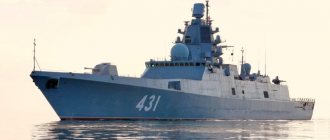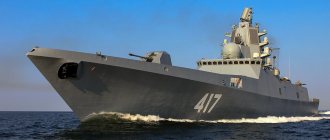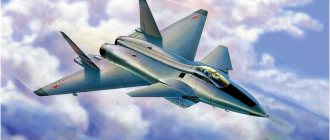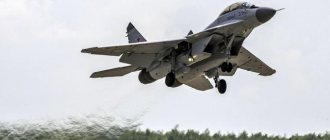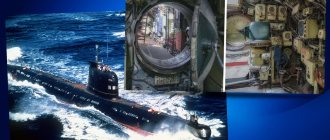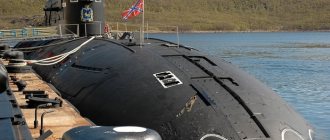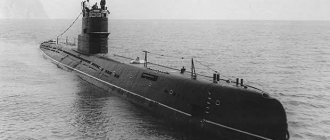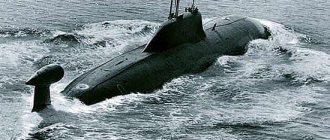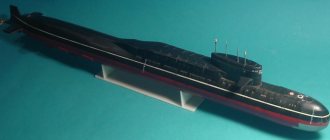Created in the 70s of the last century, Barracuda submarines have a unique hull design that has remained inimitable for 45 years. The experience gained during the development and operation of ships is widely used on modern Russian submarines.
Improved calculation methods and the use of new steel grades have already allowed the new ships to exceed the strength parameters of the titanium hulls of Project 945 Barracuda submarines. The old boats, after the planned modernization, will remain in service, presumably until the mid-2020s.
Main objectives of the Project 945 nuclear submarine
The Los Angeles-class multi-purpose nuclear submarine, which appeared in the US Navy, allowed the Americans to gain dominance in the ocean for a short time.
The 2nd generation submarines, which had previously been the main type of weapons, were significantly inferior in many technical parameters to the new American ships. At some point, the USSR found itself defenseless against the threat of a breakthrough of the country’s maritime borders by the submarine forces of a potential enemy. Only timely and adequate measures on the part of the Soviet military-industrial complex could turn the situation back to its previous direction. The Project 945 submarine, which received the name “Sierra I” according to Western classification, was created with one sole purpose - to promptly detect submarines of a potential enemy and be ready to destroy them. The new submarine had to have the necessary stealth, high speed and great firepower.
Initially, the technical specifications for the new ship outlined the mandatory conditions that the new submarine must have. The hull must be double with the most efficient, from the point of view of hydrodynamics, contours. The power plant must have one nuclear reactor of reduced size, which will provide the ship with high speed characteristics.
In addition to the high technical characteristics of the new ships, a mandatory condition was set before the creators of the project. All ships of the new series must have a displacement and dimensions that fit into the parameters of the capacities of the ship repair and shipbuilding industry of the USSR. The task set before Soviet designers in 1972 included the construction of a new 3rd generation submarine in the next 3-5 years. For this purpose, the terms of reference provided for the development at the Lazurit Central Design Bureau, located in Gorky, of a project for the subsequent construction of nuclear submarines. The terms of reference provided for the construction of submarines on a competitive basis. In parallel with the development of Project 945, intensive work was underway on another project. Based on the same technical specifications and sketch data, SKB Malakhit was designing its own ship, the multi-purpose submarine of the Pike type - Project 971.
Ship hull
Multipurpose submarines of the Barracuda type were built with double hulls. This concept not only increased the tactical and technical characteristics of ships, but also made it possible to rationally use the technical capabilities of a titanium alloy. The main hull was made entirely of titanium, while the bow and stern ends of the boat's hull were of steel construction. The shape of the light hull had perfect hydrodynamic contours - an ellipsoidal bow and a spindle-shaped stern. The robust main hull had a conical shape, both at the bow and at the stern. All bulkheads at the ends of the ship were spherical, and the fastenings of the structure could easily experience the bending stresses that arise in the hull when diving to depth.
The entire ship was divided into 6 combat compartments. Ballast tanks were equipped with scupper-type kingstones. In addition, the design of the ship provided for the installation of an emergency ascent system. The tanks were purged not with compressed air, but with fuel combustion products during the operation of auxiliary diesel engines. To evacuate the crew in emergency situations, the boat was equipped with a rescue capsule installed in the area of the central combat post. The new boat had a practical diving depth of 480 m, while the maximum permissible diving limit reached 550 m.
The main weapon of the Project 945 submarine was the TEST-71 torpedo, the warhead of which could cause critical damage to a potential enemy ship. The new torpedo had an active-passive homing system, which made its movement almost invisible to the enemy.
The radio-electronic armament of the Barracuda-class submarines consisted of the SKAT sonar system. Low noise when the ship moves underwater and the presence of new hydroacoustic equipment increased the stealth of the ship. The accuracy of determining the ship's coordinates using new equipment has increased 5 times. The range of direct communication between the ship and the base has increased several times, exceeding the previous indicators for the Soviet submarine fleet by 2-3 times.
2.1. Seawolf submarines, USA
The maximum speed under water is 35 knots (64.82 km/h).
Seawolf is a modern US submarine. Their construction took place from 1989 to 1998, during which technologies were used for the first time to increase the level of modularity of the submarine.
Seawolf submarine, USA
The hull of the Seawolf model was made of steel and its standard dimensions were changed, increasing the maneuverability of the vessel on the water.
Initially, it was planned to build 30 Seawolf submarines, then the number of units was reduced to 12, and after the collapse of the Soviet Union there was even a plan to abandon construction. As a result, it was decided to limit ourselves to 3 models, which became the most modernized and expensive submarines of the US Navy: Seawolf, Connecticut and Jimmy Carter.
This is a holiday for all of Russia
On Navy Day, which the country celebrated last Sunday, Supreme Commander-in-Chief of the Russian Armed Forces Vladimir Putin visited the main base of the Red Banner Northern Fleet, Severomorsk. Walking around the formation of Northern Fleet warships on a boat, he congratulated the crews on their professional holiday. Then, from the heavy aircraft-carrying cruiser Admiral of the Fleet of the Soviet Union Kuznetsov, via videoconference, he received a report from Severodvinsk from Deputy Prime Minister of the Russian Federation Dmitry Rogozin and Deputy Minister of Defense of the Russian Federation Yuri Borisov on the laying down of new nuclear submarines at the Sevmash Production Association.
There are not enough funds to modernize the titanium "Karp"
The modernization of the Karp nuclear submarine has been suspended indefinitely; the work is not funded, TASS reports, citing a source in the military-industrial complex. The Russian Ministry of Defense ordered the repair of two titanium submarines of Project 945 Barracuda in December 2012. In the spring of 2014, Zvezdochka began preparations for a deep modernization of the first of them, Karp. “To date, the Ministry of Defense has not yet received any documents clarifying the fate of this contract, but its financing is no longer being carried out, and all work on the project has been suspended as of today,” the agency’s interlocutor said.
The appearance of Project 945A submarines
After improving the power plant and strengthening the ships’ armament based on the existing project, new Project 945A Condor-type submarines appeared. Even at the stage of laying the 3rd and 4th ships of the series, an attempt was made to prepare the ships for the installation of the modernized OK-650B reactor. The power of the power plant increased to 48 thousand hp. New thrusters were installed on the boats, improving the maneuverability of the ship in combat conditions. The size of the ships remained unchanged, but their displacement increased to 6,400 tons. The submarine's crew is still 61 people. The main changes in the design affected the combat capabilities of the new ships. The introduction of design changes to the ship's weapon system led to the fact that on Project 945A boats the number of compartments reached 7.
The submarines were armed with six 533-mm torpedo tubes. However, the main weapon of the warship was the Granat strategic cruise missiles. One submarine carried up to 10 missiles with conventional and nuclear warheads. The launch of cruise missiles was to be carried out through torpedo tubes. Condor-class ships were armed with Igla MANPADS, which strengthened the air defense system of military ships.
The second ship of the Okun nuclear submarine series was laid down in 1989 and entered service in 1992, joining the ranks of the Russian Navy. In 1995, the boat received a new name, becoming the nuclear submarine Pskov. Further construction of new submarines was stopped. The next modernization of the ships' combat capabilities led to the laying of the Project 945B submarine (code "Mars"). However, due to the difficult financial situation in the country, it was decided not to build expensive titanium submarines in the future.
Today, the Russian Navy's roster includes all four titanium submarines. The submarines "Tula" and "Kostroma" are located at the wall of the shipyard, awaiting their future fate. Newer ships, the submarine Pskov and its sister, the nuclear submarine Nizhny Novgorod, are included in the 7th submarine division of the Northern Fleet, based in Vidyaevo. It is planned to re-equip all four ships in accordance with the technical specifications of Project 945M and arm the ships with Caliber cruise missiles.
Advantages and disadvantages
The main advantage of both the Barracuda and the Condor is their stealth. It was achieved primarily by reducing the noise level created by the submarine's mechanisms. In addition, “demagnetization” provided by the use of titanium alloys is of great importance. The composition of the weapons complex is also quite good, especially on Project 945A boats.
It is quite difficult to give an objective assessment of the level of crew safety, since only four submarines were built. In any case, the strength of the structure after the incident off Kildin Island can be considered proven.
The dynamic characteristics are excellent and do not cause any complaints. The main disadvantage of both projects is the very high cost of manufacturing a titanium case. It is this factor that made the Shchuka-B nuclear submarines, which are very close in design to the Barracudas, much more numerous - after all, they are made of relatively cheap steel.
Project 945 nuclear submarine Kostroma at its last berth
In addition, the on-board electronic equipment of Project 945 and 945A boats today looks outdated. It should have been replaced at the beginning of the 2000s, but now the prospects for further modernization look rather vague, if not completely hopeless.
History of creation
When designing second-generation multi-purpose nuclear submarines, the country's leading design bureaus and research centers simultaneously carried out work on third-generation nuclear submarines. The main reason for this was the dynamic development of the American submarine fleet, which in turn required a response from the Soviet Navy
As part of the country's anti-submarine defense concept, third-generation multipurpose submarines received special attention due to their increased search capabilities. They were considered as the main means of detecting enemy submarines, tracking them and destroying them, if the appropriate order was received.
In March 1972, tactical and technical assignments were given for the development of a Project 945 nuclear submarine under the code "Barracuda". N.I. Kvasha was appointed chief designer. The main tasks for the boats of the new project were to track strategic submarines and aircraft carrier strike groups of a potential enemy and ensure their destruction at the outbreak of a conflict. The main limitation was displacement, since construction was planned at domestic factories in the country.
An important part of the project was the creation of a durable titanium alloy body. This made it possible to increase the maximum depth by one and a half times compared to second generation boats
Also, the use of an alloy of high specific strength made it possible to reduce the displacement of the boat, which made construction possible on and subsequent transportation by inland waterways. Also, the titanium structure greatly reduced the ship's magnetic field. According to this indicator, boats 945 of the project still maintain world leadership. The only disadvantage of boats made of titanium alloys was their price. For this reason, the number of ships in the series was limited in favor of cheaper Project 971 Shchuka-B nuclear submarines, which used low-magnetic steel.
Construction[ | code]
Housing | code
The boat is built using a double-hull design. The light hull at the bow of the boat has an ellipsoidal tip, and at the stern it has a spindle-shaped tip. The durable body is made of titanium alloy and has a cylindrical shape in the middle and conical at the ends. It consists of 6 waterproof compartments. The submarine has a pop-up escape capsule that can accommodate the entire crew.
Powerplant | code
The main power plant is one OK-650A pressurized water reactor with a capacity of 43,000 hp. With. and one turbo gear unit. A reactor of this type has four steam generators, two circulation pumps each for the first and fourth circuits, and three pumps for the third circuit. The boat has two AC turbo generators, two feed pumps and two condenser pumps. There are also two groups of batteries and two reversible converters.
Armament | code
The project's boats are armed with a torpedo-missile system, which allows firing without restrictions on diving depth and includes four 533-mm and two 650-mm torpedo tubes. The ammunition capacity is 40 torpedoes and missiles.
Conventional torpedoes of various types, missile-torpedoes of the Vodopad anti-submarine missile system, and Veter anti-submarine missiles, capable of installing a nuclear warhead, can be used as ammunition for torpedo tubes.
Electronic equipment | code
Among the radio-electronic equipment on the boats of the project, the MGK-503 Skat sonar system was installed. Thanks to the reduction of the sonar system's own interference and the noise of the boat, which was significantly lower compared to boats of the previous generation, the target detection range more than doubled. The number of errors when determining the location of the boat was reduced, which made it possible to surface much less frequently to determine coordinates. New communication equipment made it possible to increase the signal reception range and their depth.
Modifications | code
945A "Condor" | code
Main article: Project 945A Condor submarines
Submarines of the improved Project 945A "Condor" had differences in the weapons complex, a new reactor and thrusters. Measures have also been taken to achieve even lower noise levels.
945B "Mars" | code
Main article: Mars (submarine)
A modification of the Barracuda project boats, which has almost the same characteristics for fourth-generation nuclear submarines. Due to a decrease in defense spending after the collapse of the USSR, construction of the only boat of the modified project laid down was stopped.
Modernization | code
It is planned to modernize both ships at the Zvezdochka CS according to Project 945M:
- replacement of nuclear fuel;
- replacement of all electrical equipment;
- inspection and repair of mechanical parts of ships;
- if necessary, reactors will also be repaired;
new ones will be installed:
- GAS;
- BIUS,
- radars,
- GLONASS/GPS navigation systems;
- weapon systems:
Breakthrough to the West: what Russian submariners did in the Atlantic
Northern Fleet exercises are the largest since the Soviet Union
This week, Norwegian media reported that there are about 10 submarines of the Russian Northern Fleet in the North Atlantic, eight of which are nuclear. In their opinion, the submariners were practicing breaking through the Faroe-Icelandic anti-submarine line and covert deployment in the waters of the Atlantic
Prime Minister Erna Solberg commented on the situation: Russia is thereby demonstrating its power and the importance of ensuring the security of the sea route towards Murmansk. She noted that Norway does not see this as a threat, but needs NATO defense
The Russian Ministry of Defense responded with a statement: “The Russian military is conducting planned combat operational training activities.” Izvestia looked into what it meant for so many submarines to go to sea and what tasks they could solve.
Trafalgar submarines, UK
The maximum speed under water is 32 knots (59.26 km/h).
Trafalgar is a modern British missile and torpedo submarine. Between 1979 and 1991, 7 modern vessels were designed and built. By 2015, 4 Trafalgar submarines were part of the British Navy, and three vessels had already been decommissioned.
Submarine Trafalgar, UK
A complete replacement and modernization of the submarines was planned for 2023. However, in 2022, information appeared about a malfunction in the reactor of one Trafalgar model, and it was decided to temporarily decommission all 4 boats for modernization.
Service history[ | code]
The first boat of the K-239 “Karp” project began its service in 1984. In 1998, after only 14 years of service, she was decommissioned and her future fate remains in doubt. The second, K-276 "Crab", entered combat service in 1987. On February 11, 1992, in Russian territorial waters, she collided with the American Los Angeles-class submarine Baton Rouge. The Crab's wheelhouse, designed to break through ice, was slightly damaged, and the Baton Rouge had a fire after the collision. After the accident, the Baton Rouge nuclear submarine reached the base under its own power and was decommissioned after some time.
Comparative assessment | code
| "Los Angeles" | "Pike" | "Pike-B" | "Barracuda" | "Condor" | "Fin" | "Ruby" | |
| Appearance | |||||||
| Years of construction | — | — | — | — | — | — | — |
| Years of service | c | c | c | c | c | c— | c |
| Built | 62 | 15 | 15 | 2 | 2 | 1 | 6 |
| Displacement (t) surface underwater | 6082 7177 | 6990 7250 | 8140 12770 | 5940 9600 | 6470 10400 | 5880 8500 | 2410 2607 |
| Speed (kt) surface underwater | 17 30-35 | 11,6 31 | 11,6 33 | 19 35 | 19 35 | 11 33 | 15 25 |
| Immersion depth (m) working limit | 280 450 | 400 600 | 480 600 | 480 550 | 520 600 | 10001250 | 300 |
Characteristics
| Parameter | Meaning |
| Displacement surface/underwater, tons | 5940/9600 |
| Length, m | 107,16 |
| Width, m | 12,28 |
| Average draft, m | 9,62 |
| Surface/underwater speed, knots | 12,1/35,15 |
| Working depth, m | 480 |
| Maximum depth, m | 550 |
| Navigation autonomy, days | 100 |
